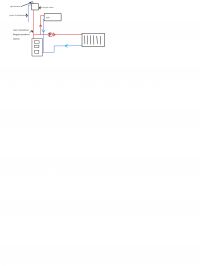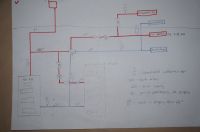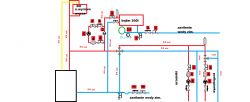I warmly welcome. I have a great request to those familiar with the topic of a simple diagram of a CO installation in an open system.
I put the scheme that I want to do and I have a question if it is correct. The drawing is general, valves, air vents, safety valves, tank protecting the boiler, etc. are coming
I am asking for an opinion whether the system connected in this way will work properly. The boiler is supposed to work by gravity when the pump turns off, which pushes water to the radiators in a forced system. A detector will be installed in the pump, which will turn it off after the temperature drops, which will prevent the water from cooling out of the DHW. Thank you in advance for any suggestions.
greetings
I would like to add that the installation was made of copper, the riser pipe I wanted to give 22 or 25 copper.

Installation at this time is done as shown in the second drawing. The expansion vessel plugged into the back with Pex raises my concerns. The differential valve also seems unnecessary to me, since the radiator system works in a forced system, it would be enough to install the pump as in the first drawing. I don't know if I think correctly.

I put the scheme that I want to do and I have a question if it is correct. The drawing is general, valves, air vents, safety valves, tank protecting the boiler, etc. are coming
I am asking for an opinion whether the system connected in this way will work properly. The boiler is supposed to work by gravity when the pump turns off, which pushes water to the radiators in a forced system. A detector will be installed in the pump, which will turn it off after the temperature drops, which will prevent the water from cooling out of the DHW. Thank you in advance for any suggestions.
greetings
I would like to add that the installation was made of copper, the riser pipe I wanted to give 22 or 25 copper.

Installation at this time is done as shown in the second drawing. The expansion vessel plugged into the back with Pex raises my concerns. The differential valve also seems unnecessary to me, since the radiator system works in a forced system, it would be enough to install the pump as in the first drawing. I don't know if I think correctly.






